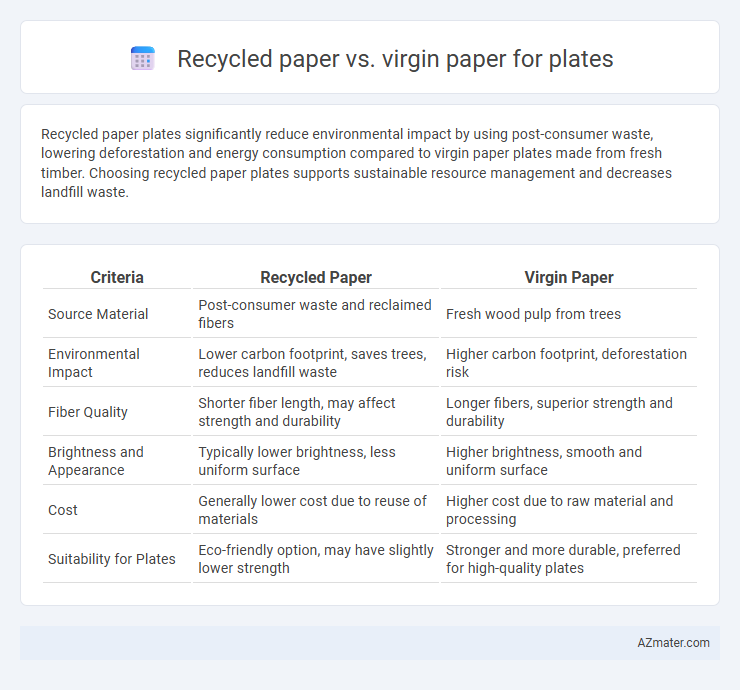Recycled paper plates significantly reduce environmental impact by using post-consumer waste, lowering deforestation and energy consumption compared to virgin paper plates made from fresh timber. Choosing recycled paper plates supports sustainable resource management and decreases landfill waste.
Table of Comparison
| Criteria | Recycled Paper | Virgin Paper |
|---|---|---|
| Source Material | Post-consumer waste and reclaimed fibers | Fresh wood pulp from trees |
| Environmental Impact | Lower carbon footprint, saves trees, reduces landfill waste | Higher carbon footprint, deforestation risk |
| Fiber Quality | Shorter fiber length, may affect strength and durability | Longer fibers, superior strength and durability |
| Brightness and Appearance | Typically lower brightness, less uniform surface | Higher brightness, smooth and uniform surface |
| Cost | Generally lower cost due to reuse of materials | Higher cost due to raw material and processing |
| Suitability for Plates | Eco-friendly option, may have slightly lower strength | Stronger and more durable, preferred for high-quality plates |
Introduction to Recycled and Virgin Paper Plates
Recycled paper plates are crafted from post-consumer waste, reducing deforestation and conserving natural resources while maintaining durability and usability for everyday dining needs. Virgin paper plates, made from freshly harvested pulp, offer higher strength and brightness, ideal for premium presentation and heavy-duty use. Both types provide sustainable options with distinct environmental impacts and performance characteristics suited to various consumer preferences.
Environmental Impact: Recycled vs Virgin Paper
Recycled paper for plates significantly reduces deforestation, water consumption, and energy use compared to virgin paper, which relies heavily on raw timber and intensive processing. The production of recycled paper generates fewer greenhouse gas emissions and decreases landfill waste by reusing post-consumer fibers. Choosing recycled paper plates supports circular economy principles and minimizes the environmental footprint associated with single-use disposables.
Manufacturing Process Differences
Recycled paper manufacturing for plates primarily involves reprocessing post-consumer fibers through deinking and cleaning, reducing reliance on raw wood pulp found in virgin paper production. Virgin paper production requires pulping fresh wood chips using mechanical or chemical methods like kraft or sulfite processes, ensuring higher fiber strength and purity. The recycled process minimizes energy use and water consumption compared to the more resource-intensive virgin paper manufacturing stages.
Resource Consumption and Sustainability
Recycled paper for plates significantly reduces resource consumption by using post-consumer waste, decreasing the need for fresh wood pulp and lowering water and energy usage by up to 70%. Virgin paper production demands extensive deforestation, high water intake, and energy-intensive processes, contributing to increased carbon emissions and habitat loss. Adopting recycled paper enhances sustainability by minimizing environmental impact, conserving natural resources, and promoting circular economy practices in plate manufacturing.
Quality and Performance Comparison
Recycled paper used for printing plates often contains shorter fibers, resulting in slightly lower durability and reduced image sharpness compared to virgin paper made from long, unprocessed fibers. Virgin paper provides superior consistency and smoother surface texture, enhancing plate quality and printing performance with higher resolution and better ink absorption. Although recycled paper supports environmental sustainability, virgin paper remains the preferred choice for critical applications requiring optimal plate longevity and print clarity.
Cost Analysis: Recycled vs Virgin Paper Plates
Recycled paper plates generally cost 10-30% less than virgin paper plates due to lower raw material expenses and reduced energy consumption during manufacturing. Virgin paper plates, made from fresh wood fiber, have higher production costs driven by resource extraction and processing requirements. Bulk purchasing of recycled options further enhances cost efficiency, making them a budget-friendly choice without compromising durability.
Health and Safety Considerations
Recycled paper for plates often contains fewer chemicals and bleaches compared to virgin paper, reducing potential exposure to harmful substances, making it a safer choice for food contact applications. Virgin paper, while typically stronger and more absorbent, may involve higher levels of chemical treatments and additives, posing greater risks of contamination or allergic reactions. Health and safety considerations prioritize recycled paper plates when certified free from harmful residues and compliant with food safety standards such as FDA regulations.
Waste Management and Biodegradability
Recycled paper plates significantly reduce waste management challenges by diverting paper from landfills and lowering the demand for virgin raw materials, which conserves natural resources and reduces deforestation. In terms of biodegradability, both recycled and virgin paper plates break down naturally; however, recycled paper plates often contain fewer chemical additives, leading to faster decomposition in composting environments. The use of recycled paper plates supports sustainable waste reduction strategies by minimizing environmental footprint while maintaining necessary functional properties.
Market Availability and Consumer Preferences
Recycled paper for plates is increasingly available due to growing environmental regulations and consumer demand for sustainable products, capturing a significant market share in eco-conscious segments. Virgin paper plates dominate in sectors requiring higher strength and food safety certifications, such as food service and catering, where consistent quality is prioritized. Consumer preferences show a rising trend toward recycled options, driven by awareness of environmental impact, though price and durability considerations still influence purchasing decisions.
Conclusion: Choosing the Right Paper Plate
Selecting the right paper plate depends on environmental impact, durability, and cost considerations. Recycled paper plates reduce deforestation and landfill waste but may have slightly lower strength compared to virgin paper plates, which offer superior sturdiness and a smoother finish. Balancing sustainability goals with functional requirements ensures the best choice for specific applications and consumer preferences.

Infographic: Recycled paper vs Virgin paper for Plate
 azmater.com
azmater.com